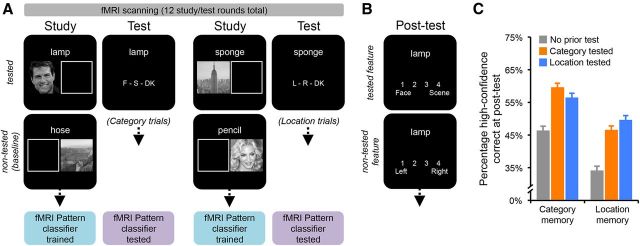Figure 1.
Experimental paradigm. A, During fMRI scanning, participants completed alternating study/test cycles. During study, participants encoded words paired with pictures of faces or scenes appearing on the left- or right-hand side of the display. Each study phase was followed by a test phase that tested source memory for some of the words. For half of the test phases, participants were asked to recall the category of the corresponding picture (F = face, S = scene, DK = don't know; category trials); for the other half, participants were asked to recall the spatial location of the corresponding picture (L = left, r = right, DK = don't know; location trials). Critically, participants did not know which feature they would be tested on until after each study phase. fMRI data from the study phases were used to train pattern classifiers to discriminate between face versus scene trials; classifiers were then “tested” on data from the test phases to determine whether patterns of encoding activity were reactivated during retrieval. B, After exiting the scanner, participants completed a post-test that probed memory for both the category and location corresponding to all previously studied words. Category memory was tested first (1 = definitely face, 2 = probably face, 3 = probably scene, 4 = definitely scene) and was immediately followed by a test of location memory for that item (1 = definitely left, 2 = probably left, 3 = probably right, 4 = definitely right). C, Post-test feature memory was considered accurate if participants selected the relevant feature with high confidence. Accuracy was considered as a function of prior testing: category previously tested, location previously tested, or no prior test (baseline). Testing a feature improved later memory for that feature, relative to baseline, but also improved later memory for the corresponding nontested (incidental) feature. The testing benefit was, however, stronger for the feature that had been tested (target) than the nontested (incidental) feature. Error bars reflect within-subject SE of the interaction.

